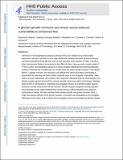| dc.contributor.author | Meyer, Retsina M. | |
| dc.contributor.author | Burgos-Robles, Anthony Noel | |
| dc.contributor.author | Liu, Elizabeth | |
| dc.contributor.author | dos Santos Correia, Susana Maria | |
| dc.contributor.author | Goosens, Ki Ann | |
| dc.date.accessioned | 2016-05-09T13:02:36Z | |
| dc.date.available | 2016-05-09T13:02:36Z | |
| dc.date.issued | 2013-10 | |
| dc.date.submitted | 2013-08 | |
| dc.identifier.issn | 1359-4184 | |
| dc.identifier.issn | 1476-5578 | |
| dc.identifier.uri | http://hdl.handle.net/1721.1/102419 | |
| dc.description.abstract | Hormones in the hypothalamus–pituitary–adrenal (HPA) axis mediate many of the bodily responses to stressors, yet there is no clear relationship between the levels of these hormones and stress-associated mental illnesses such as posttraumatic stress disorder (PTSD). Therefore, other hormones are likely to be involved in this effect of stress. Here we used a rodent model of PTSD in which rats repeatedly exposed to a stressor display heightened fear learning following auditory Pavlovian fear conditioning. Our results show that stress-related increases in circulating ghrelin, a peptide hormone, are necessary and sufficient for stress-associated vulnerability to exacerbated fear learning and these actions of ghrelin occur in the amygdala. Importantly, these actions are also independent of the classic HPA stress axis. Repeated systemic administration of a ghrelin receptor agonist enhanced fear memory but did not increase either corticotropin-releasing factor (CRF) or corticosterone. Repeated intraamygdala infusion of a ghrelin receptor agonist produced a similar enhancement of fear memory. Ghrelin receptor antagonism during repeated stress abolished stress-related enhancement of fear memory without blunting stress-induced corticosterone release. We also examined links between ghrelin and growth hormone (GH), a major downstream effector of the ghrelin receptor. GH protein was upregulated in the amygdala following chronic stress, and its release from amygdala neurons was enhanced by ghrelin receptor stimulation. Virus-mediated overexpression of GH in the amygdala was also sufficient to increase fear. Finally, virus-mediated overexpression of a GH receptor antagonist was sufficient to block the fear-enhancing effects of repeated ghrelin receptor stimulation. Thus, ghrelin requires GH in the amygdala to exert fear-enhancing effects. These results suggest that ghrelin mediates a novel branch of the stress response and highlight a previously unrecognized role for ghrelin and growth hormone in maladaptive changes following prolonged stress. | en_US |
| dc.description.sponsorship | Massachusetts Institute of Technology. Undergraduate Research Opportunities Program | en_US |
| dc.description.sponsorship | Hugh Hampton Young Memorial Fellowship | en_US |
| dc.description.sponsorship | Schoemaker Fellowship | en_US |
| dc.description.sponsorship | Singleton Presidential Fund | en_US |
| dc.description.sponsorship | James R. Killian Fellowship | en_US |
| dc.description.sponsorship | National Institute of Mental Health (U.S.) (R01 MH084966) | en_US |
| dc.description.sponsorship | United States. Army Research Office | en_US |
| dc.description.sponsorship | United States. Defense Advanced Research Projects Agency (Grant W911NF-10-1-0059) | en_US |
| dc.language.iso | en_US | |
| dc.publisher | Nature Publishing Group | en_US |
| dc.relation.isversionof | http://dx.doi.org/10.1038/mp.2013.135 | en_US |
| dc.rights | Creative Commons Attribution-Noncommercial-Share Alike | en_US |
| dc.rights.uri | http://creativecommons.org/licenses/by-nc-sa/4.0/ | en_US |
| dc.source | PMC | en_US |
| dc.title | A ghrelin–growth hormone axis drives stress-induced vulnerability to enhanced fear | en_US |
| dc.type | Article | en_US |
| dc.identifier.citation | Meyer, R M, A Burgos-Robles, E Liu, S S Correia, and K A Goosens. “A Ghrelin–growth Hormone Axis Drives Stress-Induced Vulnerability to Enhanced Fear.” Mol Psychiatry 19, no. 12 (October 15, 2013): 1284–1294. | en_US |
| dc.contributor.department | Massachusetts Institute of Technology. Department of Brain and Cognitive Sciences | en_US |
| dc.contributor.department | McGovern Institute for Brain Research at MIT | en_US |
| dc.contributor.department | Picower Institute for Learning and Memory | en_US |
| dc.contributor.mitauthor | Meyer, Retsina M. | en_US |
| dc.contributor.mitauthor | Burgos-Robles, Anthony Noel | en_US |
| dc.contributor.mitauthor | Liu, Elizabeth | en_US |
| dc.contributor.mitauthor | dos Santos Correia, Susana Maria | en_US |
| dc.contributor.mitauthor | Goosens, Ki Ann | en_US |
| dc.relation.journal | Molecular Psychiatry | en_US |
| dc.eprint.version | Author's final manuscript | en_US |
| dc.type.uri | http://purl.org/eprint/type/JournalArticle | en_US |
| eprint.status | http://purl.org/eprint/status/PeerReviewed | en_US |
| dspace.orderedauthors | Meyer, R M; Burgos-Robles, A; Liu, E; Correia, S S; Goosens, K A | en_US |
| dc.identifier.orcid | https://orcid.org/0000-0002-2570-4587 | |
| mit.license | OPEN_ACCESS_POLICY | en_US |
